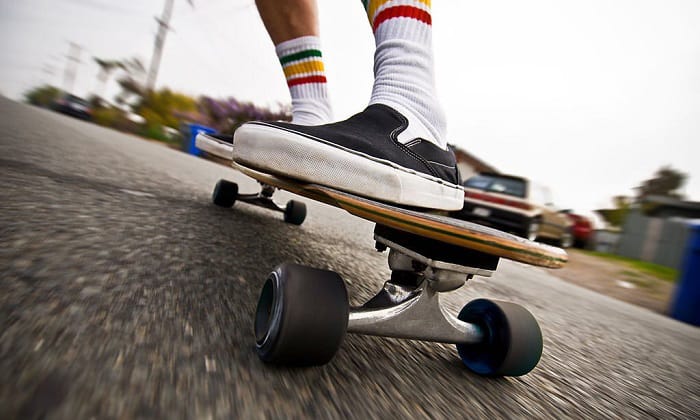Safety and protective equipment are essential for any extreme outdoor activity. These activities include skateboarding, scootering, or roller skating. However, at least one skater would likely disagree with these ideas, thinking these gears are only uncomfortable.
Let’s take skateboard shoes, for example. Are skate shoes bad for your feet? If used for just skating alone, this shoe type is usually harmless. However, if you rely on them for walking or running for long periods, your feet may get sore as a result.
So, keep reading as we list the effects of wearing skate shoes and the best pair to use.
Table of Contents
Are Skate Shoes Good or Bad for the Feet?
Two typical features of skate shoes are flat soles and thin padding. This shoe type is designed in such a way because it’s supposed to provide a good grip and board feel, allowing skaters to perform tricks more easily and safely.
However, the flat sole and thinly padded design can also hurt the feet if skaters wear the shoes for extended periods due to two primary reasons:
- The flat sole lacks arch support, so the wearer will tire more quickly when walking or standing. It’s particularly unsuitable for flat feet, which require stabilizing arc support.
- The thin padding provides little shock absorption of impact on the feet, which can increase pressure on your feet and joints.
For a deeper analysis, let’s compare the two popular skate shoe types: cupsole and vulcanized. Whereas the former has more heel and arch support due to thicker padding, it also provides less board feel, ultimately making it unsuitable for technical tricks. The opposite can be said about vulcanized shoes, such as Vans.
Pros and Cons of Skate Shoes
Since we have discussed significant differences between vulcanized and cupsole skate shoes, it’s appropriate to assess their advantages and drawbacks separately.
1. Vulcanized skate shoes
- Lightweight
- Optimum board feel
- Easier to break-in
- Not the best arch support
- Reduced protection from shock impact
2. Cupsole skate shoes
- Sturdy build
- Better impact and arch protection
- Compromised board feel
- Longer break-in period
The Potential Risks of Wearing Skate Shoes
Indeed, skate shoes do more good than bad when riding a skateboard. However, we can’t neglect that wearing them may also entail some potentially harmful effects. What are these?
- Using the wrong skate shoe cut
Besides the skate shoe type, this footwear comes in different cuts and heights. These classes include the high-top, low, mid-top, and slip-on. Failing to consider ankle protection, mobility, and bulkiness will expose the skater to significant injury threats.
So, can a famous pair of Nike SB Zoom Blazers or Vans hurt my feet? Yes.
- Inefficient learning process
Gearing up for a skateboard ride lets us expect we’ll learn or improve. And such is why we consider using skate shoes. However, an inherent risk rests in wearing the wrong pair.
Some skaters ignore such a risk by using footwear for street skating when all they do is play with ramps and parks. Hence, they could take a longer route to mastering a trick or skill.
- Joint pain
Skate shoes’ flat and thin soles can cause foot fatigue if you wear them for long periods. However, in the long run, the lack of arc support and shock absorption can also result in increased pressure and aches in the joints.
Recommendations
Whether you want a pair for lifting, running, skating, or casually going out, there’s always a footwear fit for you. So, what should we consider, and how can we prevent foot pain from skateboarding? Let’s find out here.
Choosing the Right Skate Shoes
Here’s what to consider when picking skate shoes.
- Cupsole or vulcanized shoes – Unfortunately, we can’t have a comfortable skate shoe with sufficient arch support without compromising the feel of the board.
Hence, choose a cupsole if you want more durable, shock-absorbent shoes. Use vulcanized ones to connect to the board better. - Shoe height – There is also a trade-off among skate shoe heights. Skate shoes like high tops yield the best ankle protection, while low tops allow optimum ankle mobility.
- Shoe material – Canvas, leather, and suede are the primary materials for making shoes. Canvas is light but lacks durability for heavy skating. Leather and suede skate shoes are more durable but not as breathable as canvas.
- Durability – You don’t necessarily have to shell out for a pair of expensive and overrated shoes. However, it’s wise to pay a little extra for durable footwear that can withstand heavy-duty use and high-impact tricks.
Foot Care and Injury Prevention Tips
Let’s see how we can keep our feet free from injury.
- Warm up before skating.
- Use appropriate footwear.
- Consider putting sole inserts for reduced strains.
- Cool down after skating.
- Never ride on a foot injury.
- Wear shock-absorbing socks.
Conclusion
How well we skateboard isn’t solely about our execution of basic to complicated skills. What we wear can also dictate if we’d land a trick safe or trip our ankles. Such is why footwear companies have designed skate shoes for our sport.
By now, you should know the answer to “Are skate shoes bad for your feet?” Hopefully, this knowledge will help you to determine the proper footwear for your upcoming skating trip.

Hi, I am Charles Harris. I opened this site to write as much as I can about my biggest passion – skateboarding!
I started as a clumsy yet passionate rookie 10 years ago to now a still passionate yet much better skateboarder! But I have to tell you, the whole journey has always been fun and rewarding, indeed not without hardship.








